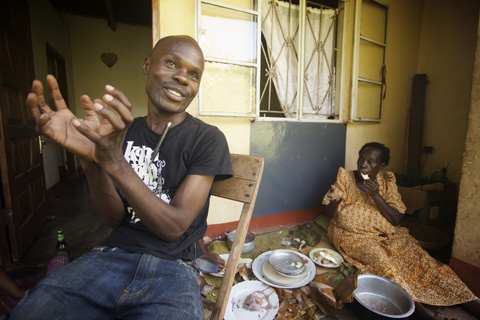
LGBT ACTIVISM IN KENYA Call Me Kuchu. |
Volume is important in each of the three documentaries screening at SPACE Gallery this weekend, under its Human Rights Film Series umbrella. In Philadelphia in 1985, an ideologically murky offshoot of the Black Power movement raises the hackles of both neighbors and city government by espousing rhetoric through the streets over megaphones attached to their urban commune. In contemporary Moscow, an art collective protests the Putin dynasty to little fanfare until they play a punk show in a Russian Orthodox cathedral. In 2011 Uganda, the country’s gay citizens and activists modulate their activities with the whims of the nation’s attention, brought to terrifying life on the ground by local media and American evangelists. All of these activists embody their beliefs at different volumes; in each case, the loud and tone-deaf stomp of an institution overreacts to perceived outrages.
The first and best of these films — one of the finest documentaries of the year — is Let the Fire Burn, screening Friday. Jason Osder’s archival film (edited by Nels Bangerter) tracks the very public debate about MOVE, a small but potent separatist group based in West Philadelphia in the late ’70s and early ’80s. Neither questions nor answers are simple. MOVE speaks in the vague but menacing tone of revolution, but anecdotes of child labor and malnutrition, weapons hoarding, and polygamy give it the air of a cult. Worse, MOVE are loud and volatile neighbors, upsetting residents who may be sympathetic to their goals and drawing the attention of the police. An attempted raid on a MOVE compound in 1978 raises tensions on both sides, resulting in the recorded beating of MOVE members and the death of a police officer.
Passions culminate in May 1985, when police move in on a new MOVE house in an episode that results in one dropped bomb, eleven deaths, and a conflagration that destroys 61 homes over a few city blocks. Local news footage reflects the chaos and confusion of the day.
Much of Let the Fire Burn is comprised of gripping footage from a special commission conducted to gather facts about how this glaring institutional overreaction came to pass. It’s striking how few facts there are to gather: police officers and city officials pass the buck high enough to implicate Philadelphia’s first black mayor in the decision to bomb the compound; former MOVE members give testimony designed to highlight the absurdities of a system they’ve lived to subvert. Osder’s film is short on context because the entire situation he recreates seemed to lack it: the movement, media, and city officials all seemed intent on stoking the fire.
With Pussy Riot: A Punk Prayer (playing Saturday night), the liberal humanist viewer will feel more at home. The serviceable film, directed by Mike Lerner and Maxim Pozdorovkin, largely reviews events its audience is well aware of: the inciting church performance and the court proceedings that landed the trio of feminist punks in jail, where two remain today. It is, however, beneficial to observe in a concentrated setting: the poise and humor of Pussy Riot’s members come into relief in longer scenes observing them in trial-room enclosures; episodes relay their biographies and the palpable outrage of the Orthodox church. Mostly, though, the broader context is two-dimensional: Putin is a cookie-cutter villain, and Russian activist culture is reduced to a couple of contemporary art pranks. This, and the lame argument that Pussy Riot are in prison (in part) because the government doesn’t understand art, is insufficient: the group itself would admit that they are the haphazard emblems of a much larger movement. The filmmakers could have spoken to many young Russians who might help explain why.